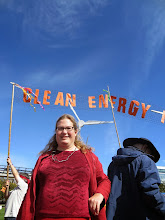At today's hearing, an administrative law judge heard oral comments in the rule making for Colorado's Community Solar Gardens Act. (He fixed glitches in the audio system himself, all in his judical robes!) The comment period was extended until April 8, and the community has been asked to provide addional comments on the minimum capitalization of solar gardens.
The Solar Gardens Institute offered comments (summarized below) to support middle and lower income subscribers, community groups, local solar integrators, and smaller installations:
- In general, make the PUC process more accessible for those who are neither attorneys nor utility specialists
- The proposed allocation for "low-income" subscribers is only 5% of the solar gardens program - only about 100 people per year. According to a study by the Low-Income Energy Assistance Program (LEAP), in 2007 22% of Colorado households earned less than 185% of the poverty line and thus would qualify for the program. Since the Solar Rewards program has no provision for low income inclusion, and generally benefits fairly well-to-do people, Solar Gardens should be more inclusive - more than 22% low income.
- The proposed real-time reporting requirements (once per ten seconds) may be hard to achieve technically with smaller inverters. Only larger systems (over 1 Megawatt) are currently required to report to the Western Regional Electric Generation Information System (WREGIS). Systems under 1 Megawatt Certainly, reporting requirements should be no more rigorous than the Solar Rewards program, and should be flexible enough to take into account future smart grid standards.
- Solar gardens should be able to connect via multiple meters in order to allow complexes of multi-unit buildings to take advantage of the program. This and other smart grid implementations should not be precluded by PUC rules.
- Solar gardens should be able to grow over time. People within a community will learn about a facility and want to join. The Ellensburg Solar Community in Washington State has added new phases each year. From the Judge's questions, it appears that I'll need to have a conversation with XCEL about how incentives could be planned ahead.
- In earlier comments, the Solar Gardens Institute suggested a separate allocation for solar gardens between 10-100 kilowatts, at least for the first three years of the program. We believe it is important to have a separate allocation for smaller systems, as some community groups have been working on their ideas for a few years. This will likely be addressed in XCEL's program rules. There were concerns the carve-out might lead to unallocated capacity, but I noted the program will likely be greatly oversubscribed.
- Make sure the program rules do preclude not a lease or lease-to-own model, essential for lower and middle income people who don't have all the money up front. PUC Staff cross examined me- I noted that most existing systems around the country use leasing. I also noted that a program similar to SMUD Solar Shares (where the customer purchases a block of kilowatt hours) would not be allowed by the statute, since the customer must have an interest (ownership or lease) in generation capacity. We sell kilowatts, not kilowatt hours.
We would love to hear questions and comments from the community!
Joy Hughes
Founder, Solar Gardens Institute
Subscribe to:
Post Comments (Atom)


You seem to feel there is a benefit to selling kilowatts versus kilowatt hours. could you explain that, or point me in a direction to learn more?
ReplyDelete